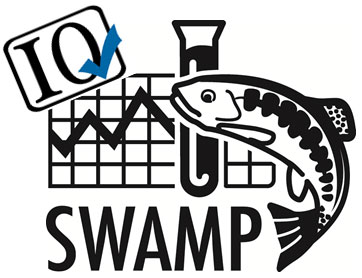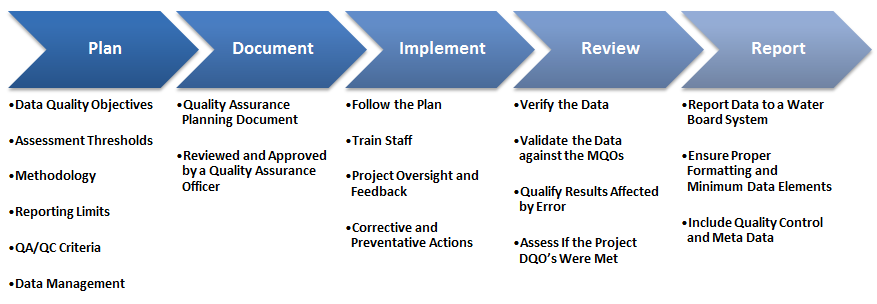
SWAMP Comparability
What is Data Comparability?

Data comparability is defined as the measure of confidence that one dataset can be compared to another and can be combined for a decision(s) to be made (US EPA QA/G-5, 2002). The Water Boards utilize data from numerous sources in carrying out their requirements under California’s Water Quality Control System to make environmental, regulatory, and public health decisions.
Therefore, when diverse data are combined to support a decision by the State or Regional Water Boards, it is important for the data to be “comparable.” SWAMP staff is tasked with assisting monitoring projects and programs with collecting and reporting data that can be utilized by the Water Boards, thus ensuring they are “SWAMP Comparable”.
Becoming SWAMP Comparable
To be SWAMP Comparable, projects and programs should share SWAMP’s goal “to collect and provide data that is well planned and documented, valid and defensible, and supportive of decisions required by California’s Water Quality Control System”.
SWAMP achieves this goal through careful project management, data review, and reporting as detailed in the SWAMP Quality Assurance Program Plan. SWAMP’s efforts are best summarized as a project lifecycle based on the principles below:

Planning
- Projects should undertake a planning process equivalent to the Data Quality Objectives (DQO) planning process to identify a project’s intended data use and select the appropriate level of quality needed.
- During this phase, projects should identify appliable use, assessment thresholds methodology, reporting limits, and create a data management plan for review, storage, analysis, and submittal of data to a Water Board system.
- Ambient surface water projects should identify which SWAMP Program Quality Objectives and SWAMP Intended Data Use Categories apply. It is highly recommended that projects apply SWAMP Programmatic Measurement Quality Objectives (MQO), where applicable, for maximum comparability with SWAMP data.
Documentation
- Projects should document relevant information in an appropriate Quality Assurance (QA) Planning document or equivalent planning document.
- The document should be reviewed and approved by an appropriate QA Officer. Consult any grant(s), permit(s), waiver(s), order(s), or other policies to determine which QA Officer approval signatures are required.
- For data intended for use with the Integrated Report, the following elements must be included in a Quality Assurance Program Plan (QAPP):
- Objectives of the study, project, or monitoring program.
- Methods used for sample collection and handling.
- Methods used for field and laboratory measurement and analysis.
- Data management, validation, and recordkeeping (including proper chain of custody) procedures.
- QA and QC requirements.
- Personnel training.
- DQOs, action levels, or requirements of the project.
- Rationale for sampling site selection, water quality parameters, sampling frequency, and methods that assure the samples are spatially and temporally representative of the surface water, and representative of conditions within the targeted sampling timeframe.
- Certification statement of the adequacy of the QAPP with name of certifying individual(s).
- Documentation to support the conclusion that results are reproducible and the DQOs were achieved.
Implementation
- To be SWAMP Comparable, projects should be implemented as described in the QA planning document.
- When issues arise, project staff should implement corrective and preventative actions where applicable.
- Records of activities should be maintained to help provide a narrative for the data and project reports, and to communicate potential data errors.
Review
- Data collected by the project should first be reviewed by the person(s) responsible for creating the data to ensure accurate entry and reporting.
- The project QA Officer or other designated staff should then verify and validate the data in order to determine compliance with the data management plan and MQOs.
- It is highly recommended that project staff also perform a data quality assessment to determine the usability of the data for the project and the Water Boards.
- For ambient surface water projects, data should be flagged/qualified utilizing SWAMP business rules for data verification and validation as found in the SWAMP Wiki page.
Reporting
- Data must be submitted to the appropriate Water Board Data System in the required format, and must include all required minimum data elements, metadata, and QC sample results.
- Ambient surface water projects should meet the minimum required data elements, metadata, QC sample results, and business rules outlined in the SWAMP Quality Assurance Program Plan (Data Management section).
- Data should then be submitted to the SWAMP database or CEDEN.
SWAMP Comparability & Certification Review
Ambient surface water project staff that wish to submit their data for SWAMP studies, the Integrated Report, or health-based advisories may submit their project QA Planning documentation and export their project data for review and potential certification by SWAMP.
The results of the review will then be provided to project staff. It is highly recommended that QA planning documentation be submitted during the early stages of the project to ensure alignment with the comparability requirements.
Projects that meet the above conditions at the conclusion of the project will be labeled as “SWAMP Certified” within CEDEN.


